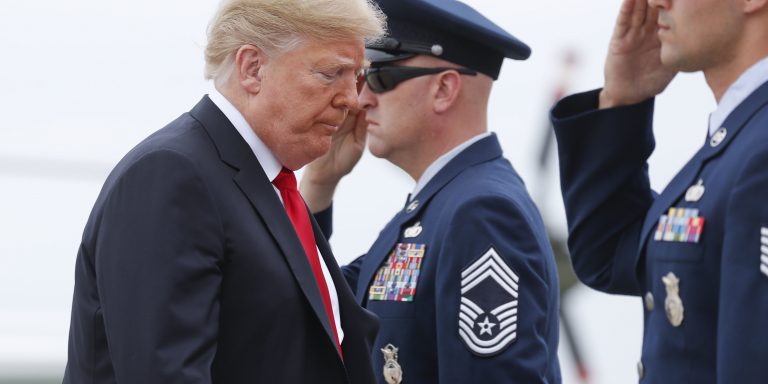INTELBRIEF
October 8, 2018
IntelBrief: ‘Old Wine in New Bottles:’ The 2018 National Strategy for Counterterrorism

- On October 04, the Trump administration released its National Strategy for Counterterrorism, the first since 2011.
- While proclaiming the 25-page document ‘sets forth a new approach,’ the strategy is mostly a continuation of approaches undertaken by previous administrations.
- There is a new emphasis on offensive cyber operations against terrorists’ use of the internet, but overall, the strategy seeks to combat the symptoms of a larger challenge without addressing root causes and both real and perceived grievances.
- Iran and ‘radical Islamist terrorists’ like the Islamic State and al-Qaeda are highlighted, while the report also notes ‘the terrorist landscape is more fluid and complex than ever.’
.
Seventeen years ago, on October 07, 2001, the United States and its coalition allies launched the ‘global war on terrorism,’ initiating military operations in Afghanistan against al-Qaeda and the Afghan Taliban. But the so-called GWOT has been semantically confused from the start—it made no sense then, just as now, to declare war against a tactic. Nearly two decades later, the war in Afghanistan continues, as does the ‘global war on terrorism,’ with no realistic prospects for a ‘victory’ or seeming end in sight. Both wars are being fueled by enormous underlying issues of abysmal and repressive governance, corruption, persistent ecological challenges, misogyny, sectarianism, and more. Yet, as with preceding strategies, the 2018 National Strategy for Counterterrorism is myopically focused on fighting the fires without removing the fuel.
While the Trump administration proclaims that the counterterrorism strategy ‘sets forth a new approach,’ it is, understandably, largely a continuation of measures adopted by the Bush and Obama administrations, with a few notable differences. The document reverts back to the ‘war’ footing of the Bush Administration, declaring at the end of the Executive Summary that ‘We are a nation at war—and it is a war that the United States will win.’ This return to the idea of a winnable war in a classic sense is at odds with the experiences of the last 17 years, where the United States deploys a world class military to conduct counter-terrorism operations in failed states and ungoverned spaces in order to kill and capture an array of terrorists, insurgents and militias.
The strategy correctly notes that countering terrorism is a full-spectrum challenge involving law enforcement, intelligence agencies, the military, and other institutions, including both government and the private sector. Yet, as with preceding administrations, the focus is on the military and law enforcement as the main pillars of the strategy, which has proven to be counterproductive and immensely expensive in the years since 2001. After untold expenditures of blood and treasure, the U.S. is still in a position where it begins the 2018 counterterrorism strategy with the hackneyed line, ‘Today's terrorist landscape is more fluid and complex than ever.’ A more effective strategy would be to devote greater resources and energy to resolving the local issues driving terrorism, with a philosophy of ‘terrorism is a global phenomenon with intensely local solutions.’ While military offensives against groups such as the so-called Islamic State and al-Qaeda are a necessity, there is an even greater need to resolve the persistent conflicts in places like Afghanistan and Syria, where both real and perceived grievances have turned these countries and the surrounding regions into the epicenter of transnational terrorism.
Somewhat predictably and in line with the administration’s rhetoric, the new strategy places a focus on Iran. It notes that the U.S. continues ‘to face threats from Iran, the most prominent state sponsor of terrorism, through its global network of operatives and its ongoing support to an array of terrorist groups.’ It also stresses that ‘radical Islamists terrorists’ like the Islamic State and al-Qaeda, both remain significant threats, while noting that the Islamic State has hemorrhaged territory and sullied its brand. Like previous strategies, the current strategy references the obvious need to be ‘agile’ and ‘expansive,’ mentions the importance of countering the ideologies of terrorism, and the need to forge and sustain effective partnerships with other nations. According to the strategy, the U.S. will ‘modernize and integrate existing counterterrorism tools’ and also ‘be pragmatic in our approach and mindful of the need to use our resources carefully.’ The strategy states quite definitively that the United States will achieve what has heretofore been unachievable: ‘Through the National Strategy for Counterterrorism, we will achieve the following end states to safeguard our homeland, way of life, and shared interests: The terrorist threat to the United States is eliminated.’ This objective remains equal parts desirable and quixotic.
.
For tailored research and analysis, please contact: info@thesoufancenter.org
[video width="960" height="540" mp4="https://thesoufancenter.org/wp-content/uploads/2018/10/IB-1008.mp4" poster="https://thesoufancenter.org/wp-content/uploads/2018/10/AP_18279793812434.jpg"][/video]